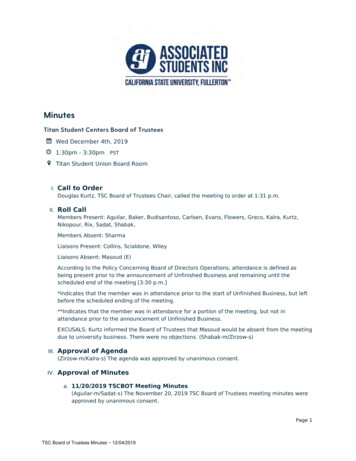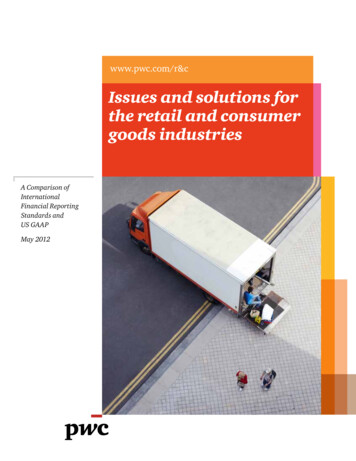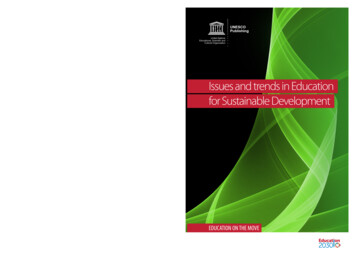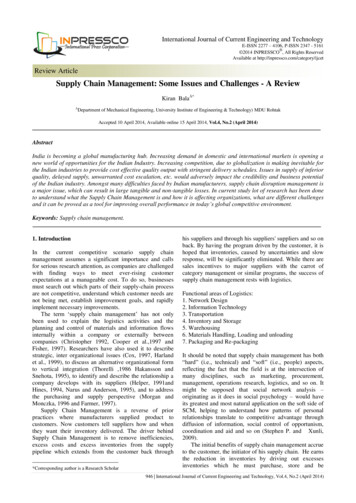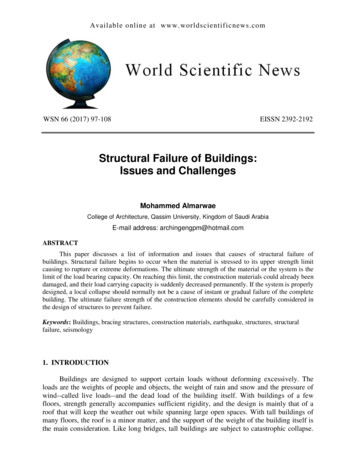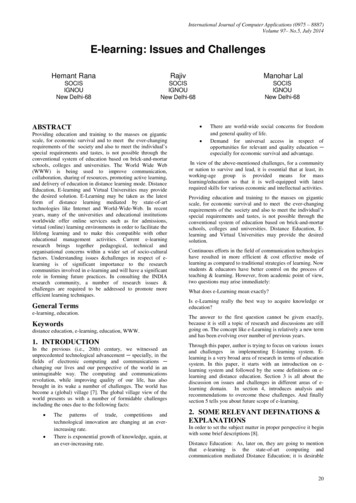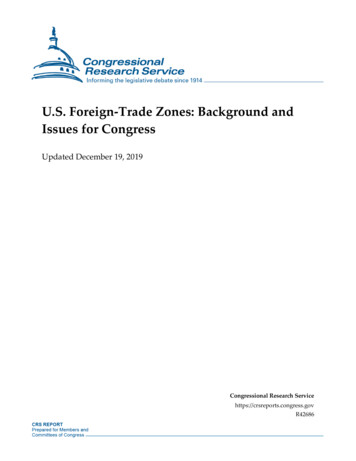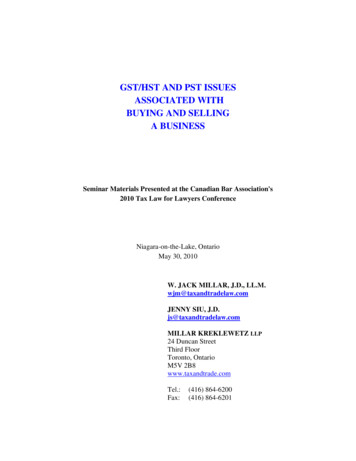
Transcription
GST/HST AND PST ISSUESASSOCIATED WITHBUYING AND SELLINGA BUSINESSSeminar Materials Presented at the Canadian Bar Association's2010 Tax Law for Lawyers ConferenceNiagara-on-the-Lake, OntarioMay 30, 2010W. JACK MILLAR, J.D., LL.M.wjm@taxandtradelaw.comJENNY SIU, J.D.js@taxandtradelaw.comMILLAR KREKLEWETZ LLP24 Duncan StreetThird FloorToronto, OntarioM5V 2B8www.taxandtrade.comTel.:Fax:(416) 864-6200(416) 864-6201
IITABLE OF CONTENTSOVERVIEW . 1PART I - GOODS AND SERVICES TAX . 21. INTRODUCTION TO THE GST. 2(a)General Scheme of the ETA . 2Exempt Supplies . 3Zero-rated Supplies . 3Place of Supply Rules . 3Residents & Non-Residents . 4Permanent Establishments . 4Carrying on Business . 5(b)Registration, Collection, and Return Obligations . 6(c)Input Tax Credits . 7(d)Harmonized Sales Tax . 82. APPLICATION OF GST TO A SHARE PURCHASE . 8(a)Supply of Shares Exempt . 8(b)Purchaser’s Recovery of GST on Acquisition Costs . 9(i)“Takeover Fees”. 9(ii) Holding Companies . 11(iii) Multi-Tiered Corporations. . 12(c)Possible Recovery of Vendor’s Disposition Costs?. 13(i)Section 185. 13(ii) Section 186. 15(iii) Takeover Bid & IPO Expenses . 15(iv) ITC’s for Employee Relocation Costs . 16(d)GST Due Diligence . 173. APPLICATION OF GST TO AN ASSET PURCHASE . 18(a)Introduction . 18(b)GST Treatment of Typical Business Assets . 19(i)Capital Real Property . 20(ii) Capital Personal Property . 24(iii) Financial Assets . 25(iv) Contracts for Future Supplies . 26(v) Inventory . 26(vi) Intellectual Property . 27(vii) Customer Lists . 27(viii) Goodwill . 27(ix) Non-Competition Agreements . 28
III(c)Section 167 Election . 29(i)Introduction . 29(ii) Filing Requirements . 30(iii) Meaning of “Business that was Established” and “All or Substantially All” . 31(iv) Business or Part of a Business . 31(v) Established Business . 32(vi) All or Substantially All of the Property Necessary to Carry on the Business . 32(vi) Part of a Business . 35(vii) Exempt Assets Can Be Sheltered Under Section 167 . 35(viii) Application to turn-key operations . 35(ix) Specific Exclusions . 36(x) Filing Requirements . 36(x) Other Considerations . 36(xi) Alternatives to Section 167 . 39(d)Section 167.1 Treatment of Goodwill . 40(e)Closely Related Corporations . 40Section 156 and Butterfly Reorganizations . 42Other Corporate Reorganizations . 43Partnerships and Section 156 Election . 454.AMALGAMATIONS . 455. WINDING-UP . 466. PARTNERSHIPS . 46PART II - PROVINCIAL SALES TAXES . 501. INTRODUCTION . 502. TAX BASE . 51(a)British Columbia . 51(i)Tangible Personal Property . 51(ii) Taxable Services . 52(b)Saskatchewan . 53(i)Tangible Personal Property . 53(ii) Taxable Services . 53(c)Manitoba . 53(i)Tangible Personal Property . 53(ii) Taxable Services . 54(d)Ontario . 54(i)Tangible Personal Property . 54(ii) Taxable Services . 54(e)Prince Edward Island . 55(i)Tangible Personal Property . 55(ii) Taxable Services . 553. PST ON SPECIFIC ASSETS . 55
IV(a)Inventory . 55(b)Fixtures . 56(c)Production Equipment . 57(d)Research and Development Equipment . 58(e)Computer Software . 584. BULK SALE ISSUES . 58(a)British Columbia . 59(b)Saskatchewan . 59(c)Manitoba . 59(d)Ontario . 59(e)Prince Edward Island . 60(f)Special Collection/Remittance Considerations . 605. EXEMPTIONS FOR AMALGAMATIONS, WIND-UPS, RELATED PARTY SALES &UNRELATED PARTY SALES . 61(a)British Columbia . 61(b)Saskatchewan . 65(c)Manitoba . 67(d)Ontario . 70(e)Prince Edward Island . 726. PARTNERSHIP TRANSACTIONS . 74(a)British Columbia . 75(b)Saskatchewan . 76(c)Manitoba . 77(d)Ontario . 79(e)Prince Edward Island . 80CONCLUSION . 81
1OVERVIEWThis paper addresses the application of the Goods and Services Tax (“GST”), Harmonized SalesTax1 and the various Provincial Sales Taxes (“PST”) to the purchase and sale of a businessthrough asset transactions, share transactions and various other types of corporatereorganizations. Part I of the paper deals exclusively with some of the GST issues and Part IIaddresses the PST issues.There are essentially two ways of acquiring an existing business. One can purchase all of theassets used in operating the business or, if the business is operated as a corporate entity, one canpurchase all of the corporation’s issued and outstanding shares. We have divided Part I of thepaper (the GST portion) into six separate subparts, including (i) an introduction to the GST; (ii)an overview of the GST issues associated with a share purchase, including some due diligenceconcerns; (iii) the application of the GST to specific types of assets and the potential use ofvarious relieving provisions, including the section 167 election; (iv) amalgamations; (v) windups/liquidations; and (vi) partnership transactions.Part II of the paper only addresses the application of the PST to asset transactions, sincecorporate securities (shares, bonds, debt instruments, etc.) are not subject to the PST. Part II hasbeen divided into six subparts including (i) an introduction to the PST; (ii) an overview of eachprovince’s PST legislation; (iii) the PST status of specific types of business assets in eachprovince; (iv) the PST bulk sale issues; (v) the PST exemptions for specialized transactionsincluding related party transfers, amalgamations and wind-ups; and (vi) the PST issues forpartnership transactions.Quebec’s retail sales tax was replaced in the mid-1990’s with the Quebec Sales Tax (“QST”),which is a Quebec-imposed value-added type tax which is generally - although not completely harmonized with the GST. One important and helpful difference between the GST and the QSTsystems is that financial services are considered a “zero-rated” supply for the QST purposes;whereas, financial services are exempt supplies for the GST purposes. This distinction isimportant since input tax credits (refunds) are available for “zero-rated” but not for exemptsupplies.1As of April 1, 1997 Nova Scotia, New Brunswick and Newfoundland and Labrador repealed their retail sales taxlegislation. For supplies made in these “participating provinces”, the 15% (now 13%) Harmonized Sales Tax or “HST”is made up of a 7% (now 5%) federal component and an 8% provincial component.
2PART I - GOODS AND SERVICES TAX1. INTRODUCTION TO THE GST(a)General Scheme of the ETAThe GST is levied under Part IX of the Excise Tax Act (the “ETA”). It is a 5%2 value-added taxwhich is generally levied on all supplies of property and services made in, or imported intoCanada. The GST is levied under three separate Divisions in Part IX of the ETA. Division IIimposes the GST on taxable supplies made in Canada. Division III imposes the GST onimported goods and Division IV imposes the GST on “imported taxable supplies other thangoods”, such as imported services.While almost everyone is required to pay the GST on their purchases of taxable property andservices, GST registrants can generally recover the GST paid when the property and services arebeing utilized in commercial activities. This tax recovery by GST registrants is achieved throughthe ETA’s input tax credit mechanism. Registrants account for the GST collected on theirtaxable supplies and the GST paid on their inputs by remitting the difference between the taxcollected and the tax paid. Where a supplier has paid more tax on its inputs than it has collectedon its supplies, the excess is refunded to the registrant. In this regard, the GST is imposed onlyon the value-added by the registrant during each stage in the manufacture and supply process.Since individual consumers of property and services will generally not be registered under theETA, they will not be entitled to claim input tax credits in respect of their purchases and, as such,ultimately bear the full burden of the GST.There are three types of supplies for the GST purposes: (1) taxable supplies; (2) exempt suppliesand (3) zero-rated supplies.Under Division II of the ETA, GST is imposed on every recipient of a “taxable supply” “made inCanada”.3 A “taxable supply” means a supply that is made in the course of a “commercialactivity”, which by further definition includes supplies made in the course of a business, anadventure or concern in the nature of trade, and supplies of real property, but excludes exempt2Please note that pursuant to the 2007 federal Economic Statement on October 30, 2007, the GST rate has been reducedto 5%, effective January 1, 2008.3Every recipient of a “taxable supply” is required to pay the GST on the “value of the consideration for the supply”.Pursuant to section 153, the “value of the consideration for the supply” is deemed to be equal to (a) the amountexpressed in money; and (b) where the consideration or that part is other than money, the fair market value of theconsideration or that part at the time the supply was made.
3supplies. A “taxable supply”, however, excludes the making of “exempt” supplies that areenumerated in Schedule V of the ETA.Exempt SuppliesSuppliers of exempt supplies are not required to collect the GST on their supplies as they aredeemed not to have been made in the course of a “commercial activity” and, as such, are not“taxable supplies”. Vendors engaged in making exempt supplies generally pay the GST on theirpurchases, and since they are not engaged in commercial activities, they cannot recover any GSTpaid through the ETA’s input tax credit mechanism. In this way, an exempt supplier's inputs aretaxed, but their value-added escapes taxation.“Exempt supplies” are enumerated in Schedule V of the ETA and include supplies of usedresidential real property, health care services, educational services, personal care services, childservices, legal aid services, charitable services, public sector organization services, financialservices, and ferry, road and bridge tools.Zero-rated SuppliesSimilar to purchasers of exempt supplies, purchasers of “zero-rated” supplies do not have to paythe GST. Unlike persons making exempt supplies, however, suppliers of “zero-rated” goods andservices are engaged in commercial activities and, as such, are entitled to recover the tax paid ontheir purchases through the ETA’s input tax credit mechanism. In this way, “zero-rated”property and se
purchase all of the corporation’s issued and outstanding shares. We have divided Part I of the paper (the GST portion) into six separate subparts, including (i) an introduction to the GST; (ii) an overview of the GST issues associated with a share purchase, including some due diligence
